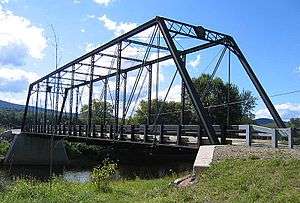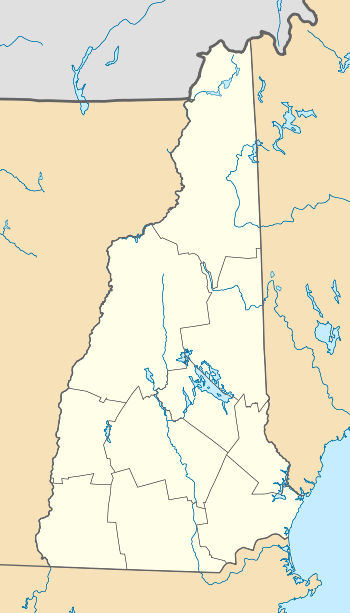Janice Peaslee Bridge
The Janice Peaslee Bridge (formerly known as the Maidstone-Stratford Hollow Bridge[3]) is a pin-connected steel & wrought iron Pratt through truss bridge crossing the Connecticut River between Stratford, New Hampshire and Maidstone, Vermont.
Janice Peaslee Bridge | |
|---|---|
 | |
| Coordinates | 44°39′6.69″N 71°33′45″W |
| Carries | Pedestrian and vehicular traffic |
| Crosses | Connecticut River |
| Locale | Stratford, New Hampshire to Maidstone, Vermont |
| Characteristics | |
| Design | Pin-connected steel & wrought iron Pratt through truss bridge[1] |
| Load limit | 20 tons |
| History | |
| Opened | 1893, 2005 |
| Closed | 1990[2] |
 Janice Peaslee Bridge Location in New Hampshire | |
History and construction
The bridge was originally completed in 1893 by the Berlin Iron Bridge Company, East Berlin, Connecticut. It was closed "temporarily" in 1990 for safety reasons.[2] Due to the perseverance of Vermont State Representative Janice L. Peaslee, it underwent a total rebuild which was completed in 2005.
In order to facilitate reconstruction of the abutments, the bridge was placed on land for repairs while the foundations were rebuilt and a new approach was created.
Since the bridge was resurrected as a result of Janice Peaslee's efforts, the bridge was renamed in her honor in 2006.
Image gallery
 Original maker's mark circa 1893
Original maker's mark circa 1893 New maker's mark circa 2005
New maker's mark circa 2005
References
- See the "new maker's mark" sign
- Nashua Telegraph article
- New Hampshire law renaming the Bridge